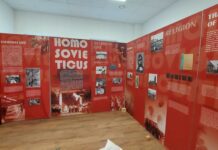
Irene Guilford’s work has appeared in various journals and anthologies, and has been short-listed in both the CBC Literary Competition and the Event Creative Non-Fiction Contest. ‟Waiting for Stalin to Die” marks her second publication of fiction with Guernica, following her novel, ‟The Embrace” (1999).
She is also the editor of Alistair MacLeod: Essays on His Work. Her writing has appeared in journals such as ‟Grain”, ‟Quarry” and ‟Lituanus”, and anthologies such as ‟Without a Guide” and ‟Kitchen Talk”. She has been shortlisted for the CBC Literary Competition, the Event Creative Non-Fiction Contest and the Writers’ Union Postcard Story Competition. She has attended the Banff Writing Studios and, for ten years, was involved in the Eden Mills Writers’ Festival.
Irene, TŽ readers would like to know more about you. You live in Toronto with your husband Nigel (and a dog, we are told). Were you always a writer? When did you begin writing and what prompted you to pursue this path?
Growing up, my interests were languages, literature and music. But I also loved the sciences. This led to a degree in mathematics and a career in computers. In the 1970s, especially for women, this was a good place to be. For twenty years, it was satisfying and fun.
One day, I found myself in a meeting with IBM types. Everyone around me was excited about a particular project. Their mouths were moving but I couldn’t hear what they were saying. It was like being in a silent cocoon. And it came to me that I was in the wrong place.
That evening, Nigel and I had a conversation. I wanted to write, but what would it be like writing every day? Would I be able to do it? Then there was the solitude, the self-discipline, the rejections from publishers. Would I like this kind of life? Would he support me for a year while I tried? Of course he would. At the end of the year, we had a second conversation. I don’t want to go back. I knew that a year ago. Obviously, I married the right man.
What made you decide to write about Lithuanians?
Because the stories are compelling and close to my heart. Because the experiences should not be allowed to vanish. Because the same problems still exist in the world today. Because it’s good not to forget.
Your first book, “The Embrace”, was very well-received here. We know it was translated into Lithuanian (other languages?). How did it fare in Lithuania? What can you tell us about the readership there?
Under the auspices of Violeta Kelertas, the book was translated in Chicago. The translators were Dalia Cidzikaite and Ausra Velickaite. The publisher was Mackaus Fondas. The title was Prisilietimas. This was in 2002. In 2003, under the guidance of Saulius Zukas, Baltos Lankos issued the book in Vilnius. The title was Glebys.
The Embrace. Prisilietimas. Glebys. The sight of these three books, sitting in a row on a shelf, is one of the great thrills of my life.
How else were you able to measure the success of your first book?
The English print run was one thousand. Over time, the book sold out. It’s out-of-print now. For a first novel by an unknown author, this is success. Guernica took a risk on me. They gave me a chance. Through them, I became a published author – with a book! It’s hard to explain the depth of my gratitude.
Equally meaningful is everything that happened around the book. It was read, discussed, and written about. There were invitations to Santara in Chicago and the Book Fair in Vilnius. Vilniaus Universitetas invited me to speak. They put the book on the curriculum. Students use it in their studies. Such things stay with you.
Tell us about your editing of Alistair MacLeod’s essays. How did that come about? And what drew you to this project?
Guernica had started a new series of books called “Authors: Essays on Their Works”. Each book would contain an extensive interview with the author, followed by essays on the work. The editor’s job would be to find an interviewer, solicit essays, and write the introduction. They offered me such a book. I could choose any author I wanted.
I had been unable to settle to new work. And I knew right away who I would do. Alistair MacLeod. From the very first paragraph, his words had gripped me. The language, the themes, the view of life, the intensity of experience. Somehow, it seemed very Lithuanian. He’s my desert-island author. The contributors were Douglas Gibson, Karl Jirgens, Janice Kulyk Keefer, Colin Nicholson, Shelagh Rogers and Jane Urquhart. It was wonderful to work together on an author whom we admired and loved. Alistair himself – sadly, deceased now – was a delight. He gave a copy of the book to each of his six children for Christmas. Then it was time to get back to my own writing.
What triggered your second novel?
For many years, this book was a distant glow on the horizon. I wrote four other manuscripts. None of them satisfied me. None was good enough to submit for publication. They got set aside. But each book brought me one step closer to that golden glow. Then one day, I was there. It was like standing at the front door of a house. Well, I was going to step inside, explore the inside of that house, take my time and do my very best.
How long did it take to write?
My writing process is very slow. A first sentence occurs to me. I write it down. Then, I wait. A second sentence arrives. I write it down. I wait again. Eventually, a paragraph forms, then a page, then a chapter and finally, a book. It takes a long time. Years. In a way, I’ve been writing, or preparing to write this novel, my entire life. In hindsight, that’s not a bad thing.
Interview by Ramune Jonaitis





























